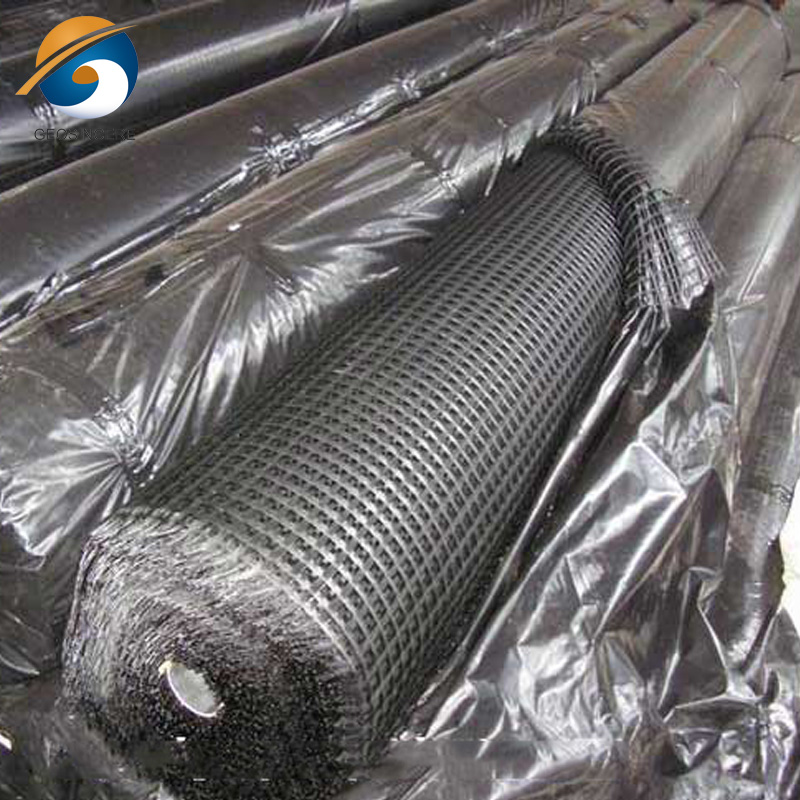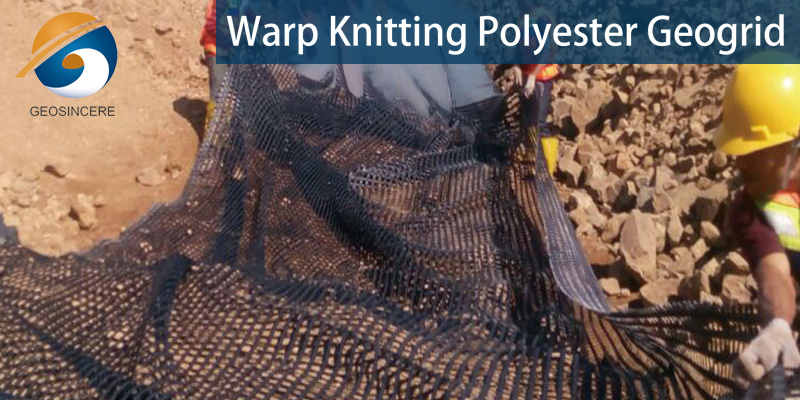Driveway Warp Knitting Polyester Geogrid
Warp knitting polyester geogrid is a type of geosynthetic material used in civil engineering and construction projects. Geogrids are typically made from high-strength polymer materials.Warp knitting refers to a specific method of manufacturing textiles, where the yarns are interlocked vertically along the length of the fabric. This technique produces a stable and durable fabric structure. In the case of warp knitting polyester geogrids, the polyester yarns are knitted together in a warp knitting machine to form a grid-like pattern.
Polyester is a commonly used material for geogrids due to its excellent tensile strength, resistance to UV degradation, and chemical stability. These properties make polyester geogrids suitable for a wide range of applications, including soil stabilization, retaining walls, slope reinforcement, and pavement reinforcement.
Warp knitting polyester geogrid can be used in the construction of driveways to provide reinforcement and stabilization. When properly installed, it helps to improve the load-bearing capacity and longevity of the driveway surface.By incorporating warp knitting polyester geogrid into the driveway construction, it helps to distribute the loads more evenly, reducing the potential for cracks, potholes, and other surface deformations. The geogrid acts as a reinforcement layer, improving the overall strength and stability of the driveway.
Geogrid acts as a reinforcement layer within the driveway structure. It is typically placed between layers of base materials, such as aggregate or asphalt, to enhance the overall strength and stability of the driveway. The geogrid's high tensile strength helps to resist the forces exerted on the pavement, thereby improving its performance under heavy traffic loads.
Warp knitting polyester geogrid is known for its durability and resistance to environmental conditions, such as moisture and temperature variations. This makes it suitable for long-term applications in driveway construction.
Parameter
ltem | PET20-20 | PET30-30 | PET40-40 | PET50-50 | PET80-80 | PET100-100 | PET120-120 | |
Elongation (%) | 13% | |||||||
Intensity (kN/m) | Longitudinal | 20 | 30 | 40 | 50 | 80 | 100 | 120 |
Transverse | 20 | 30 | 40 | 50 | 80 | 100 | 120 | |
Grid (mm) | 12.7*12.7 25.4*25.4 | |||||||
Breadth (m) | 1-6 | |||||||
Driveway Warp Knitting Polyester Geogrid Features
Excellent mechanical properties and long-term stability.
High tensile strength.
High wear resistance.
Anti-corrosion resistance.
Balanced vertical and horizontal strength.
Strong tearing resistance.
Excellent soil surface adaptability, especially the tilted or curved surface.
High resistance to dynamic impact load and vibration activity.
Strong strengthening ability.
Excellent resistance to differential settlement.
Easy to install.
Applications of Driveway Warp Knitting Polyester Geogrid
Driveway warp knitting polyester geogrid has become a vital geosynthetic reinforcement material in modern civil engineering, especially for driveway base stabilization, subgrade reinforcement, and long-term load distribution. Its combination of high tensile strength, dimensional stability, and resistance to environmental degradation makes it an ideal solution for enhancing the performance of paved and unpaved road structures.
This guide provides a detailed technical analysis of warp-knitted polyester geogrid, covering material composition, performance characteristics, design principles, regulatory standards, and procurement guidance—ensuring readers make informed, code-compliant decisions in driveway construction.
Table of Contents
What Is Warp Knitting Polyester Geogrid?
Engineering Functions in Driveway Applications
Manufacturing Process and Material Composition
Key Technical Specifications and Performance Metrics
Standards and Regulatory Compliance
Installation Guidelines for Driveway Projects
Application Scenarios and Case Example
Frequently Asked Questions
Conclusion and Actionable Recommendations
1. What Is Warp Knitting Polyester Geogrid?
Warp knitting polyester geogrid is a biaxial or uniaxial geosynthetic grid composed of high-modulus polyester (PET) yarns. These yarns are arranged in a warp-knitted pattern, then coated—typically with polyvinyl chloride (PVC) or bituminous latex—to provide resistance against UV degradation, moisture, and mechanical damage.
Features:
High tensile strength (≥ 50–400 kN/m)
Low creep deformation under long-term loads
Excellent junction strength between ribs
High chemical and biological resistance
Long service life in both wet and dry conditions
2. Engineering Functions in Driveway Applications
In driveway construction, polyester geogrids serve the following engineering functions:
Subgrade Reinforcement: Increases bearing capacity of weak soils
Base Course Stabilization: Reduces aggregate migration and rutting
Load Distribution: Evenly disperses vehicular load to prevent settlement
Crack Prevention: Mitigates reflective cracking in asphalt overlays
Material Cost Reduction: Reduces base thickness without compromising strength
🔍 Design Insight: Using geogrid reinforcement can reduce aggregate base layer thickness by up to 30%, while increasing pavement service life by over 50%, based on finite element modeling (FEM) and field trials.
3. Manufacturing Process and Material Composition
Materials:
Yarns: High tenacity polyester (PET), minimum 1000 denier
Coating: PVC, SBR, or bitumen coating for environmental protection
Manufacturing Steps:
Yarn Warping
Warp Knitting (ISO 4915 compliant)
Thermal Stabilization
Chemical Coating & Drying
Roll Packaging (typically 3.95 m × 50 or 100 m)
4. Key Technical Specifications and Performance Metrics
| Parameter | Typical Value | Test Method |
|---|---|---|
| Tensile Strength (MD/CD) | 50–400 kN/m | ISO 10319 / ASTM D6637 |
| Elongation at Break (%) | < 13% | ISO 10319 |
| Junction Strength | > 80% of rib strength | GRI-GG2 |
| Coating Mass | 20–30 g/m² | Manufacturer Spec |
| Creep Reduction Factor (CRF) | ≤ 1.5 | ASTM D5262 |
| Chemical Resistance | Excellent (pH 2–10) | ISO 13438 |
| UV Resistance | > 90% (after 500 hrs) | ASTM D4355 |
5. Standards and Regulatory Compliance
Ensure that the geogrid complies with relevant national and international standards:
| Standard / Code | Description | Authority |
|---|---|---|
| ISO 10319 | Tensile properties of geogrids | ISO |
| EN 13250 / EN 13251 | Reinforcement for roads and retaining structures | CEN (EU) |
| ASTM D6637 | Tensile strength of geogrids | ASTM (USA) |
| AASHTO M288 | Geotextile/geogrid use in transportation projects | AASHTO (USA) |
| GRI-GG2 | Junction strength testing | Geosynthetic Institute |
6. Installation Guidelines for Driveway Projects
Site Preparation:
Excavate and compact the subgrade to design depth
Remove organic matter and unstable soil
Grade surface to required elevation
Geogrid Placement:
Unroll geogrid perpendicular to traffic direction
Overlap adjacent rolls by 300–500 mm, secured with U-pins or staples
Avoid wrinkles and folds during placement
Base Material Placement:
Backfill with crushed stone or gravel (per design spec)
Compact in 150–200 mm lifts using a vibratory plate or roller
Maintain clean, dry, and tight contact with the geogrid during compaction
📌 Field Tip: Do not drag construction equipment directly over unfilled geogrids. Always place 10–15 cm of cover material before vehicle traffic.
7. Application Scenarios and Case Example
Common Driveway Uses:
Residential driveways over clay or silty soils
Farm access roads
Temporary site roads
Private estate roads with periodic heavy truck traffic
Case Example:
In a 2023 installation for a 40-meter residential driveway built on silty clay, engineers used biaxial PET warp-knitted geogrid (100 kN/m) with a 150 mm compacted crushed aggregate base. The geogrid reduced rutting by 67% compared to a control section and extended service life by 8+ years.
8. Frequently Asked Questions
Q1: How is warp-knitted geogrid better than extruded geogrid?
Warp-knitted PET geogrids offer higher tensile strength, better junction strength, and superior creep resistance under sustained loading—ideal for long-term driveways and roads.
Q2: Can I use this geogrid for gravel-only driveways?
Yes, especially in soft subgrade conditions. It prevents gravel loss and reduces the need for frequent resurfacing.
Q3: Is PVC coating necessary?
Yes. Coating improves UV stability, chemical resistance, and protects the polyester yarn during installation.
Q4: What is the expected lifespan?
Properly installed, a warp-knitted PET geogrid can last over 50 years, depending on environmental exposure and load frequency.
Q5: Where can I source driveway geogrids that meet these standards?
Certified geogrids meeting ASTM, ISO, and EN specifications can be sourced directly through this site, which offers compliance-backed materials and technical support.
9. Conclusion and Actionable Recommendations
Warp-knitted polyester geogrid is a high-performance reinforcement solution tailored for driveway and access road applications. Its superior mechanical properties, chemical stability, and regulatory compliance make it a preferred choice for long-lasting subgrade and base stabilization.
To ensure optimal performance:
Select the appropriate tensile grade and coating type
Confirm material complies with ASTM D6637 / ISO 10319
Follow proper installation protocols and engineering designs














